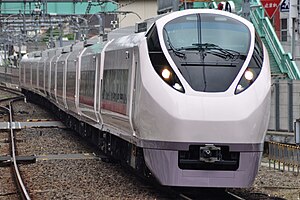Hitachi (Japanese train)

E657 series EMU
|
|
| Overview | |
|---|---|
| Service type | Limited express |
| Locale | Japan |
| First service | 1963 (Hitachi) 1989 (Super Hitachi) 1997 (Fresh Hitachi) |
| Current operator(s) | JR East |
| Former operator(s) | JNR |
| Route | |
| Start | Shinagawa/Ueno |
| Stops | Iwaki |
| Line used | Jōban Line, Tōhoku Main Line |
| On-board services | |
| Class(es) | Green + Standard |
| Catering facilities | Trolley service |
| Technical | |
| E657 series | |
| Track gauge | 1,067 mm (3 ft 6 in) |
| Electrification | 1,500 V DC / 20 kV AC 50 Hz |
| Operating speed | 130 km/h (80 mph) |
Hitachi (ひたち?) is a limited express train service operated in Japan by East Japan Railway Company (JR East) on the Jōban Line between Shinagawa Station and Ueno Station in Tokyo and Iwaki in Fukushima Prefecture. The Tokiwa service follows the same route but makes additional stops.
The Hitachi (ひたち?) name was first introduced on 1 October 1963 for a semi-express service which operated daily between Ueno and Taira (present-day Iwaki) using 451 series EMU stock, will all cars reserved. This service operated until 30 September 1967.
The name was subsequently reintroduced on 1 October 1969 for a once-daily seasonal limited-express service operating between Ueno and Iwaki using 7-car KiHa 81 series diesel multiple units. This became a regular daily service the following year.
485 series EMUs were phased in from 2 October 1972, and were used until services were discontinued in December 1998. From 1 April 1973, one return service daily was extended to operate between Ueno and Sendai. From 1 October of the same year, the number of services to and from Sendai was increased to six return services. From 2 October 1978, this number was increased to 11 return services daily, to 12 from 15 November 1982, to 23 from 14 March 1985 with the discontinuation of the Tokiwa express, and to 26 return services daily from 1 November 1986.
During the 1990s, services were operated using Katsuta-based seven-car 485 series formations with no Green car accommodation. Fourteen-car formations were sometimes used.
...
Wikipedia
